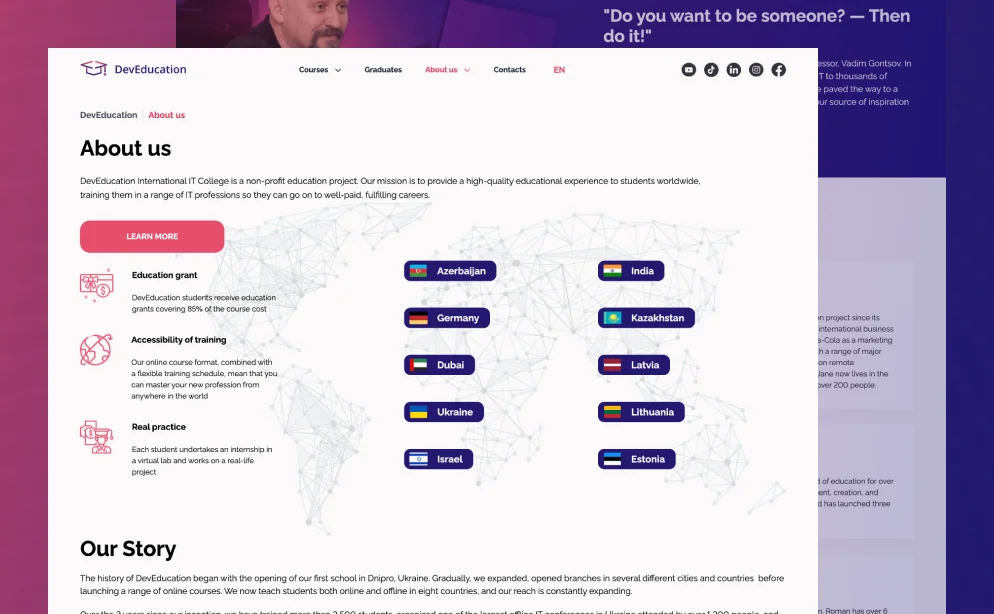Uber has a Dispatch system (Dispatch optimization/DISCO) in its architecture to match supply with demand. This dispatch system uses mobile phones and it takes the responsibility to match the drivers with riders (supply to demand). These systems have much more complex architecture and there are a lot of components joined together internally to provide riding services all over the world. Designing Uber (or OLA or Lyft) is a quite common question in system design rounds in interviews. A lot of candidates get afraid of this round more than the coding round because they don’t get an idea that what topics and tradeoffs they should cover within this limited timeframe. Firstly, remember that the system design round is extremely open-ended and there’s no such thing as a standard answer.
- Let’s take a closer look at the different technologies involved in each element.
- Uber has hundreds of WebSocket servers that establish persistent connections between both kinds of clients and the rest of the backend.
- We represent the road segment distance or the traveling time through the edge weight.
- This is the reason that Uber uses Google S2 library, which divides the entire map location into tiny cells (say 1km x 1 km cell), and then provides a unique ID for every such cell.
- And data storage depends on Hive, HDFS, Elasticsearch, MapReduce, and file storage web services.
- It also tracks vehicles attributes like the number of seats, type of vehicle, the presence of a car seat for children, if a wheelchair can be fit.
- If it’s getting close to the time limit, the app lets you text or call your passenger to find out where they are.
But when it came to scaling and expanding, monolithic architecture failed to deliver. In the US alone, Uber has grabbed a market share of around 70%, and 25% of Americans use Uber at least once per month. After launching in 2009, within 13 years, Uber is now present across cities, 69 nations, and counting.
Exploring Uber’s Tech Stack & Software Architecture — The Tech Behind Series
With Snap Rounding, which is a geometric technique, any application can swiftly use accurate coordinate representations to implement a service request, robustly. This is the reason that Uber uses Google S2 library, which divides the entire map location into tiny cells (say 1km x 1 km cell), and then provides a unique ID for every such cell. That trip from Destination A to Destination B seems pretty simple, and straightforward, but behind this trip, there are thousands of servers, coding, architecture and system design for ensuring 100% success.

And yes, every driver rates you right after you leave the Uber vehicle at the dropoff point. This is to protect future drivers from having to deal with rude, violent, aggressive, and drunk/impaired passengers. If your rating is too low, Uber can bar you from using the service temporarily or permanently. Uber offers a range of service tiers, spanning from single riders and groups up to executive limo services. The Uber app will show you the driver’s details, such as name, photo, and type of car so you know what to look for. However, you can tip with cash if you prefer not to add the tip via the app.
Why Did Uber Charge Me If I Didn’t Ride?
In 2014 he acquired Ridester.com to share his experiences with other drivers. His insights are regularly quoted by publications such as Forbes, Vice, CNBC, and more. He is currently working on a book about working in the Gig Economy, expanding his skill set beyond the rideshare niche.

So now we can easily filter the data which we need and also which belongs to that cell. That way we had a list of supplies available in all the cells and we can calculate ETA. Earlier Uber was using the RDBMS PostgreSQL database but due to scalability issues uber switched to various databases. Uber uses a NoSQL database (schemaless) built on top of the MySQL database. Before launching a new operation in a new area, Uber onboarded the new region to the map technology stack. In this map region, we define various subregions labeled with grades A, B, AB, and C.
Tips for Uber Riders
Camp and Kalanick found Uber’s first full-time CEO, Ryan Graves, via a post on Twitter. Kalanick consequently took over the post in December 2010, moving Graves to the role of general manager and senior vice president of global operations. Schemaless is an in-house NoSQL database built on top of MySQL.
You can also use Uber Pass, which is essentially a subscription to Uber that gives you discounted rides. However, simply copying this tech stack without doing your own research can be detrimental to your business model. Also, applying the same technologies will not guarantee success for your cab-hailing business. However, as the platform grew, the need for new features also surged. And to integrate new features, the development team had to deploy all the code at once. This affected the app’s speed and made the process of introducing new features extremely risky and time-consuming.
What does Uber offer?
However, as the company grew and expanded, it needed a more robust and scalable infrastructure to support its millions of users and drivers. As a result, one of the critical innovations in Uber’s tech stack has been the development of its real-time data processing platform called Apache Kafka. When the user requests a ride then the request lands on the Web Socket.
Uber sometimes places an authorization charge at the start of the trip. As an app, you may be wondering what forms of payment Uber accepts and how exactly you pay. Unless your driver was horrible, be mindful of giving less than five stars and affecting your driver’s ability to earn their income. However, you should know that drivers depend heavily on tips to make enough money to make the job worthwhile. You can direct them to the exact spot, thank them for the ride, and hop out of the car. Download the Uber app to your iPhone or Android smartphone if you haven’t already.
DISCO
The Demand Service tracks the GPS location of the user when requested. It also tracks the requirements of the orders for example, https://www.globalcloudteam.com/ whether a rider requires a small or big car. These demand requirements must then be matched against supply inventory.

One of the things that contributed the most to Uber’s rise was the dedicated team that was proud of the work they were doing. In every country, a customized Uber management structure was followed. Once the build an app like uber ride is over the rider has to pay the amount billed to them. The app calculates the prices as per the distance and base fare. It is always debated whether a service was demanded first or supplied first.
DOMA (Domain-Oriented System Architecture)
Then the Demand Service request for Supply Service with the information of the ride(what type of ride, how many rides needed, what’s the location). The supply service now knows the location(cell ID) of the User(Rider) and requests one of the servers on the server ring. In Consistent Hashing, we have equally distributed the responsibility. Like that all the location data equally distributed among the servers like the below image(blue color). The supply service is now trying to figure out the CABS which are near to the Rider from the servers by calculating the ETA values.